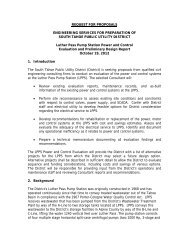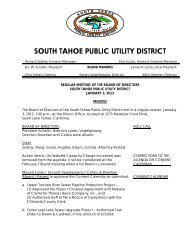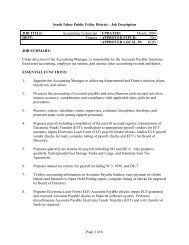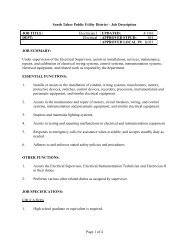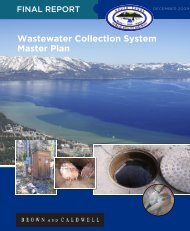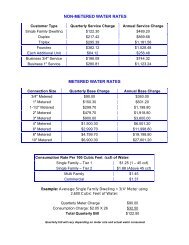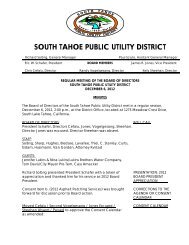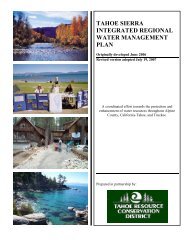October 2009 - South Tahoe Public Utility District
October 2009 - South Tahoe Public Utility District
October 2009 - South Tahoe Public Utility District
You also want an ePaper? Increase the reach of your titles
YUMPU automatically turns print PDFs into web optimized ePapers that Google loves.
• Residence Setback – No spray irrigation is allowed within 100 ft of a residence or place<br />
where public exposure could be similar to that of a park or playground for secondary 23<br />
and secondary 2.2 water.<br />
• Runoff – Irrigation runoff shall be confined to the recycled water use area unless<br />
otherwise authorized by the regulatory agency.<br />
• Drinking Water – Drinking water fountains must be protected against contact with<br />
recycled water spray, mist or runoff.<br />
6.2.3 Title 17<br />
Title 17 regulates one aspect of the distribution of recycled water. The focus of Title 17 is<br />
protection of drinking water supplies through control of cross-connections with potential<br />
contaminants. Examples of potential contaminants to potable water supplies are sewage; nonpotable<br />
water supplies such as recycled water, irrigation water, and auxiliary water supplies; fire<br />
protection systems; and hazardous substances.<br />
Table 1 of Title 17, Group 4, Article 2 – Protection of Water System, specifies the minimum<br />
backflow protection required on the potable water system for situations in which there is<br />
potential for contamination to the potable water supply. Recycled water is addressed as follows:<br />
• An air-gap separation is required on “Premises where the public water system is used to<br />
supplement the reclaimed water supply.”<br />
• An air-gap separation is required on “Premises where reclaimed water is used and there<br />
is no interconnection with the potable water system. A reduced pressure principle<br />
backflow prevention device may be provided in lieu of an [air gap] if approved by the<br />
health agency and water supplier.”<br />
An air-gap separation is defined as “a physical break between the supply line and a receiving<br />
vessel.” A reduced pressure principle backflow prevention device is defined as “ a backflow<br />
preventer incorporating not less than two check valves, an automatically operated differential<br />
relief valve located between the two check valves, a tightly closing shut-off valve on each side of<br />
the check valve assembly, and equipped with necessary test cocks for testing.”<br />
6.3 Nevada Regulation<br />
Due to the proximity of the recycled water use area in Alpine County to the California-Nevada<br />
state line, the potential exists for the <strong>District</strong> to transport water into Nevada for crop or pasture<br />
irrigation. Nevada‟s laws concerning recycled water use are substantially similar in intent to<br />
California‟s, but are more rigid in their structure and end-user requirements.<br />
6.3.1 Nevada Division of Environmental Protection<br />
The Nevada Division of Environmental Protection (NDEP), Bureau of Water Pollution Control,<br />
governs recycled water reuse in Nevada. The Nevada Revised Statutes, Chapter 445A,<br />
contains requirements for the use of reclaimed, or recycled, water. Chapter 445A.275 cites:<br />
“A person using treated effluent for irrigation by flooding or sprinklers shall use effluent<br />
that has received at least secondary treatment. As used in this subsection:<br />
<strong>South</strong> <strong>Tahoe</strong> <strong>Public</strong> <strong>Utility</strong> <strong>District</strong><br />
Recycled Water Facilities Master Plan - <strong>October</strong> <strong>2009</strong> Page 6-44



